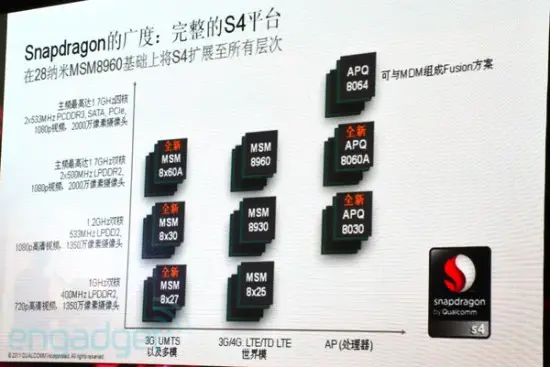Qualcomm Shows Off New S4-Class Snapdragon Processors – Compatible With 1st Gen Snapdragon Devices
At the 2011 Uplinq Conference in China, Qualcomm showed off 2 of the latest additions to their S4-class SoC family with the upcoming MSM8625 and the MSM8225 dual-core processors. This pair of S4-class chips can reach clock speeds of 1GHz and come equipped with an Adreno 203 GPU and integrated 3G modem.
While no means a powerhouse by today’s standards, the real benefit these chips provide is that they are actually compatible with current software and hardware using the older single-core MSM7X27A and MSM7X25A 1st generation Snapdragon processors. This means it wouldn’t be difficult for hardware makers to upgrade some of their aging devices with more powerful dual-core chips. Low-end devices might not be so “low-end” anymore. These new S4 chips will be available in the first of 2012.
For more information, Qualcomm’s full press release can be found below.
Qualcomm Brings Snapdragon S4 Processors to High Volume Smartphones and Expands Qualcomm Reference Design Development Platform and Ecosystem Program
– Addition of Two New Snapdragon S4 Mobile Processors Compatible with QRD Development Platforms Brings Dual-Core Processing and Integrated 3G Connectivity to High Volume Smartphones –
SAN DIEGO, Dec. 8, 2011 /PRNewswire/ — Qualcomm Incorporated (NASDAQ: QCOM) today announced two additions to its Snapdragon® S4 class of mobile processors: the MSM8625 and the MSM8225 chipsets. Both chipsets provide dual core CPUs operating up to 1 GHz, Qualcomm’s Adreno® 203 GPU and an integrated 3G modem. The MSM8625 and MSM8225 chipsets are designed to be hardware and software compatible with the MSM7x27A and MSM7x25A family of chipsets, giving device manufacturers the ability to seamlessly migrate their existing Snapdragon S1-based designs to S4 dual core-based designs. This capability is particularly useful for device manufacturers to efficiently expand their smartphone product lines with more advanced and more capable 3G smartphone products.
To further simplify and improve time-to-launch of cost effective 3G solutions for device manufacturers, Qualcomm also announced the third-generation of its Qualcomm Reference Design (QRD) ecosystem program to enable third party device manufacturers to develop differentiated high volume smartphones with lower development costs and faster time to market. The QRD ecosystem program includes a comprehensive set of software and hardware components that allows third party hardware and software vendors to have their products pre-tested and optimized for the QRD development platform. A pre-tested and optimized platform gives device manufacturers a development platform with the hardware components (memory, sensors, touch panels, cameras, displays, RF, etc.) and software applications and features (browsers, map/navigation, mail, music, instant messaging, fonts and languages, etc.) needed for basic smartphone functionality already in place. This allows device manufacturers to focus their engineering resources on developing value-added features that will help make their high-volume smartphone stand out from the competition. The QRD ecosystem program is designed to help device manufacturers developing products for regions whose networks are evolving from 2G to 3G and high volume smartphones are becoming increasingly popular.
The MSM8625 and MSM8225 chipsets will be available on Qualcomm’s third generation QRD development platform in the first half of 2012, in addition to being available as standalone chipsets. QRD development platforms based on both the MSM7x27A and MSM7x25A chipsets are currently available. Qualcomm has shipped over 100 million MSM7225 and MSM7227 chipsets, and smartphones based on these chipsets are operating on multiple carrier networks worldwide.
“Smartphones present a large business opportunity for many of our customers, which is why we have created the QRD ecosystem program to assist them with developing compelling product designs with competitive differentiation,” said Cristiano Amon, senior vice president of product management at Qualcomm. “The program combines all the elements our customers need to get a new smartphone design to launch quickly and cost effectively, from carrier-ready hardware and software to local technical support resources.”
“As Snapdragon processors power many of today’s most popular smartphones, we are working to port a variety of our core applications to the various QRD platforms,” said Chengmin Liu, senior executive vice president of Tencent, China’s largest integrated internet services provider. “This will offer our customers a strong processing solution to power our applications for future smartphone designs.”
